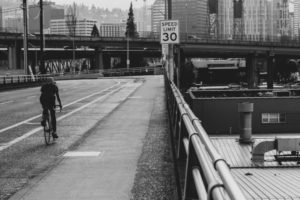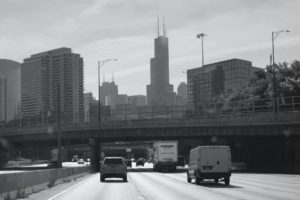This is the second essay by Lea Schweitz written as part of the Collegeville Institute’s Emerging Writers program. Each of the four writers will publish six essays over the course of their year, receiving mentorship from writing coach Michael N. McGregor.
Long before I put on my bike helmet that morning for a crosstown ride, I had been stretching the boundaries of my urban neighborhood’s contemporary redlining. Years earlier, I arrived on the South Side of Chicago for graduate school. My university-sponsored orientation included a police officer’s strict admonition to stay within the campus police patrol zone. Several years later, despite the warning, my husband and I and our two young sons lived just south of one line. My favorite coffee shop was just north of another, and our favorite library was to the west of a third. We couldn’t go too far east because we’d fall into Lake Michigan.
However, that morning’s bike ride felt different. I was afraid to venture so much farther beyond the boundaries I had been warned not to cross. I was a white woman setting off to ride alone for almost five miles through three mostly Black and Latino neighborhoods. These neighborhoods make headlines for gun violence, but rarely for the systemic violences which are its causes or for the creative businesses growing there. One of the latter was the explicit reason for my bike ride. My destination was a quirky food business incubator in an old, re-imagined, repurposed meatpacking plant. I was beginning an apprenticeship as a beekeeper and the main workshop and apiary were there. The other hives we cared for were in nearby community gardens, urban farms, and city lots, which were anything but vacant. Commuting by bike was optional, but we did all our beekeeping by bicycle, too. I had no choice but to pedal on.
These neighborhoods make headlines for gun violence but not its causes and not for the creative businesses growing there.
The first two miles of the journey was a traffic-laden game of car-dodging to navigate a confusing set of turn-lanes and pseudo-bike lanes to get past the expressway. It was clear that the urban planners had little interest in helping bikes or cars to get over the expressway or beyond its on and off ramps. However, after negotiating my way across the expressway, there was a mile-long, straight stretch of tree-lined boulevards where the wind seemed to breathe as deeply as I did. The wind and I were free of the expressway tangle, and it was mostly open road. I played leapfrog with a city bus as we passed one another, exchanging waves and making room for one another to ride forward. Mostly, there were blooms and bees and birds and a welcome stillness that felt deep, especially after the frenzy of the freeway. The final leg turned north past a city park where I encountered more birds than human neighbors. What was clear was that neither the birds nor the people were paying my fear or me any attention.
Fear and I had been traveling together for a long time before this bike ride; we go way back. Panic attacks extend through generations in my family tree. Usually, in the face of such fear, I wield my super power of invisibility. I go stealth, ride under the radar, stay behind the scenes. I keep myself and my fear safe by hiding.
Neither the birds nor the people were paying my fear or me any attention.
Along the way, I had been taught—or perhaps convinced myself—that concealing myself and my fear was a Christian virtue. Like cleanliness, invisibility seemed next to godliness. Hide yourself and follow Jesus. Pride goes before the fall. As a woman growing up in the church, the messaging had been clear—invisibility was a noble cloak. It could pass for humility.
But on a bike, you have to get yourself seen. You make eye contact with drivers at stop signs; you warn pedestrians with an “on your left!” You position yourself to take up as much room as possible between opening car doors and the ride along traffic. Be visible or your future includes only a dead biker memorial. Invisibility may have helped me get by in the past, but on my bike it could get me killed.
Nothing happened on that morning bike ride except my fear began to shapeshift into shame. Prior rides on the lakefront bike path had not prompted such worries about being seen and my own visibility. I thought it was just the lack of cars, but those rides didn’t make visible the whiteness I wished to hide. As I biked my way to a new job, there was nothing to keep either my implicit bias or my white privilege invisible from myself. And, I had to face the truth that hiding—invisibility—was not a virtue.
When I talk with my two boys about truth telling and lying, we have quickly discovered how after a lie has been told, you often need to tell another to prop it up. One lie almost always depends on another to keep it alive. Often, once one falls, others quickly fall, too. My morning ride exposed my fear as a lie, and the rest of the story has been crumbling. From the admonition of the police officer that “good girls don’t go there” to the trumped up sense of danger if I did. It was spatial profiling. The fear that I felt came from a racist lie built on racist lies. Upon being caught in this web of lies, I was tempted to hide my fear and implicit bias with the familiar cloak of invisibility. But, my bike ride unmasked this practice as unholy. Invisibility fuels implicit bias and fear and does not keep me—or my neighbors—safe.
My morning ride exposed my fear as a lie.
At recent protests in the wake of yet more murders of Black men and women by police in the United States, there are pictures of signs asking: “Where is the church?” The question raises my suspicions that fear, shame, and invisibility are colluding again, propping each other up, keeping one another alive, whispering false promises of safety if only they stay hidden. I desperately want for myself and my mostly white church to be done with this fear, but nothing will change if racist lies aren’t challenged openly. Invisibility gives both fear and racist ideas power they do not deserve. It keeps the beauty of a bike ride down boulevards lined with trees and creative businesses hidden just beyond the expressway.
Like this post? Subscribe to have new posts sent to you by email the same day they are posted.





Lea, this is a thoughtful and beautifully written piece. I’ve traveled the streets you describe, but only invisibly, within my doors-locked car. You write truth. Thank you.
I first wanted to say “exquisite,” but thought that’s not enough. So I searched the MSWord thesaurus, and can add “superb,” “perfect,” “flawless,” “discerning,” “acute.” Really, it’s one of the freshest contributions I’ve seen to the white privilege conversation–coming at the whole issue of lying from an unfamiliar slant. And: “It was spatial profiling” — brilliant.